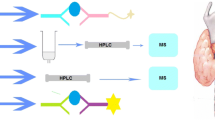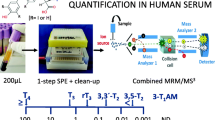Abstract
Reversed-phase liquid chromatography-inductively coupled plasma mass spectrometric hyphenation was used for iodine speciation in human serum. First investigations showed that iodine species nearly quantitatively were eluted in the void volume. The result indicated that protein-linked thryoid hormones were not interacting with the stationary phase, thus being not retained. Investigations were performed about T4-TBG (thyroxin-thyroxin-binding globulin) complex generation and its retention during chromatography. It was shown that T4-TBG was not retained on the column. Therefore, a protease treatment was introduced for serum sample preparation. The analysis of “normal” sera (after protease) gave reasonable results lying in the range published in literature: I-:11; di-iodothyrosine (DIT): 2.1; mono-iodothyrosine (MIT): 1.6; reversed tri-iodothyronine (rT3): 3.9; T3: 5.9; T4: 60; each micrograms iodine per liter. The method also proved to recognize abnormalities in a pathologic serum, having rT3 as the predominant species. In this case the method obviously was superior compared to standard immunoassay methods, as it is monitoring the iodine in the species (physiologically active iodine species), whereas immunoassay methods may sometimes detect deiodinated (inactive) compounds.
Similar content being viewed by others
References
E. J. Underwood, Trace Elements in Human and Animal Nutrition, 4th ed., Academic, New York (1977).
A. S. Prasad, Trace Elements and Iron in Human Metabolism, Plenum, New York (1978).
W. Buchberger, J. Chromatogr. 439, 129–135 (1988).
H. Keller, Klinische-chemische Labordiagnostik für die Praxis. Analyse, Befund, Interpretation, Georg Thieme Verlag, Stuttgart (1991).
W. Reinhardt, M. Luster, K.H. Rudorff, C. Heckmann, S. Petrasch, S. Lederbogen, et al., Eur. J. Endocrin. 139, 23–28 (1998).
L. M. Robison, P. W. Sylvester, P. Birkenfeld, J. P. Lang, and R. J. Bull, Toxicol. Environ Health Part A, 55, 93–106 (1998).
G. Knapp, B. Maichin, P. Fecher, S. Hasse, and P. Schramel, Fresenius J. Anal. Chem. 362, 508–513 (1998).
K. Müller, Clin. Chim. Acta 19, 21–29 (1967).
G. Geyrtyanfy, J. Földes, and E. Kollin, Z. Klin. Chem. Klin. Biochem. 9/3, 117–122 (1971).
E. Makowetz, K. Müller, and H. Spitzy, Mikrochem. J. 10, 194–201 (1966).
W. Buchberger and U. Huebauer, Mikrochim. Akta 111, 137–142 (1989).
B. Michalke and P. Schramel, Electrophoresis 20, 2547–2553 (1999).
K. Takatera and T. Watanabe, Anal. Chem. 65, 759–762 (1993).
B. Michalke, P. Schramel, and H. Witte, Biol. Trace Element Res. 78, 67–79 (2001).
J. Falbe and M. Regitz (eds.), Römpp Chemie Lexikon, 9. Auflage, Georg Thieme Verlag, Stuttgart (1995).
The Merck Index, 10th ed., Merck, Rathway, NJ (1983).
B. Michalke, P. Schramel, and S. Hasse, Mikrochim. Akta 122, 67–76 (1996).
N. Gilon, M. Potin-Gautier, and M. Astruc, J. Chromatogr. A 750, 327–334 (1996).
P. Schramel and S. Hasse, Mikrochim. Akta 116, 205–209 (1994).
A. M. Saboori, N. R. Rose, H. S. Bresler, M. Vladuttalor, and C. L. Burek, Clin. Exp. Immunol. 113(2), 297–302. (1998).
A. M. Saboori, N. R. Rose, and C. L. Burek, Clin. Exp. Immunol. 113(2), 303–308 (1998).
Author information
Authors and Affiliations
Rights and permissions
About this article
Cite this article
Michalke, B., Schramel, P. & Witte, H. Iodine speciation in human serum by reversed-phase liquid chromatography-ICP-mass spectrometry. Biol Trace Elem Res 78, 81–91 (2000). https://doi.org/10.1385/BTER:78:1-3:81
Received:
Accepted:
Issue Date:
DOI: https://doi.org/10.1385/BTER:78:1-3:81




